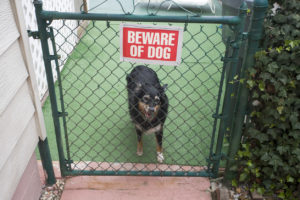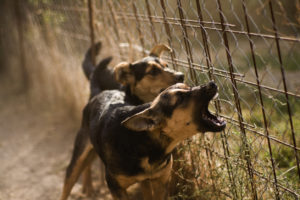- “Beware of Dog” signs, or signs with similar wording, are commonly used to discourage others from entering the owner’s home or yard without permission and to protect the public from dog attacks.
- While warning others about a dangerous dog can help prevent attacks from happening, it may offer little protection from legal claims if someone is injured. What impact, if any, a yard sign has on your case depends on the circumstances.
- Factors such as the sign’s wording and visibility or whether the victim was trespassing at the time of the attack can affect the dog owner’s legal liability.
- In legal claims involving invitees, the plaintiff must show that the dog owner knew or should have known their dog was aggressive or at risk of biting and was careless in handling it or allowing it to be around other people. The plaintiff must also show that they did not provoke the dog attack.
When a dog owner’s negligence causes someone to be attacked, the victim may have a legal claim for compensation for their dog bite injuries. Some dog owners post signs in their yards to warn others about their animals and to discourage people from entering their property. Many of these dog owners think that posting yard signs can also protect them from legal liability if someone is injured on their property.
However, while warning others about a dangerous dog can help prevent attacks from happening, it may offer little protection from legal claims if someone is injured. What impact, if any, a yard sign has on your case depends on the circumstances.
Factors such as the sign’s wording and visibility or whether the victim was trespassing at the time of the attack can impact the dog owner’s legal liability. In some cases, posting a warning sign about a dangerous dog may help the victim win their legal claim because it shows that the dog owner knew their pet was a safety risk.
Homeowners with Dogs Believe Signs Protect Them
It is common practice for homeowners with dogs—particularly large or aggressive ones—to post signs on their property that warn others about their animals. A “Beware of Dog” sign is usually meant to discourage others from entering the owner’s home or yard without permission and to prevent attacks on members of the public. These signs, which come in a variety of sizes, colors, and wording, are sold online and at stores.
While many dog owners place warning signs voluntarily, others are required to post signs when their dog has been classified as vicious or dangerous under Georgia law. Under O.C.G.A. § 4-8-25, a dog may be classified as dangerous if it:
- Punctures a person’s skin through biting,
- Attacks a person and causes injury, even if the injury is not serious (note that an “attack” can include chasing someone without making physical contact), or
- Kills another domestic animal while away from its owner’s property.
A dog may be classified as vicious if it seriously injures someone or causes them to be seriously injured while fleeing an attack. If your dog has been classified, you are required to register it with the state and meet heightened safety requirements, which includes posting a “clearly visible sign warning that there is a dangerous dog on the property” where the dog is located. O.C.G.A. § 4-8-25(2)(A).
Regardless of whether a dog owner is required by law to post a sign or does so voluntarily, many people think that such signs protect them from liability in the event of an attack. The reality, however, is that warning signs may help reduce dog attacks because people are more likely to be cautious or avoid your property, but the viability of these signs as a legal defense is less solid.
Do Georgia Laws Shield Homeowners with Dangerous Dogs if They Display Warning Signs on Their Property?
Not usually. In general, posting a yard sign may offer limited protection under certain circumstances, but it does not absolve dog owners of their duties under Georgia’s “Responsible Dog Ownership Law” or local county/city ordinances. In any Georgia dog bite case, the victim must prove that the dog owner was aware that the dog was vicious or dangerous and was careless in handling the dog, allowing it to be around other people, or allowing it to roam free. O.C.G.A. § 51-2-7. The victim must also show that they did not provoke the dog.
Putting up a sign warning that a dog may be dangerous does not shift the dog owner’s responsibility to other people. The owner still has a legal duty to properly restrain or secure a dangerous dog to protect the public. Further, posting a sign that describes the dog as dangerous can help the victim prove that the dog owner had prior knowledge that the animal was a bite risk.
Of course, many dog attacks happen away from the owner’s property in areas where a dog and a stranger may interact, such as a city park or a neighborhood street. If the attack does not take place on the owner’s property, any posted warning signs are not relevant to the issue of negligence.
In some cases, a yard sign may help protect the dog owner from liability because placing a warning sign on your property does put people on notice that your dog might attack if antagonized or provoked. If, for example, someone stuck their hand through a fence to pet a dog despite a posted warning sign, the court may find them negligent for their dog bite injuries because they disregarded the warning.
Likewise, if someone trespasses on property despite a warning sign, the dog may bite the intruder to protect the owner and/or its territory. In that situation, the court will likely find that the intruder committed a crime and provoked the dog, which means they cannot recover compensation for their injuries under Georgia law.
Keep in mind that the sign must be visible to the public to be used as a defense. If the sign is hard to read, too small, off in the distance, or unable to spot at night, the victim may argue they did not see it and could not have known about the presence of a dangerous dog. Additionally, if the sign simply says “No Trespassing” or uses some other neutral language that does not indicate a dangerous dog, the victim may argue they were not aware of the risks in interacting with the dog.
How Dog Bite Legal Claims Work if a Victim Is Invited onto the Property
When it comes to people they invite onto their property, dog owners need to take measures to prevent their dogs from hurting invitees. Invitees can include family and friends who come to socialize or people working on your property, such as contractors, postal workers, and delivery people. A warning sign may let your guests know that a dangerous dog is present in your home or on your property, but it falls on you to ensure that your dog cannot harm them.
In legal claims involving invitees, the plaintiff must show that the dog owner knew or should have known their dog was aggressive or at risk of biting and was careless in handling it or allowing it to be around other people. The plaintiff must also show that they did not provoke the dog attack.
For example, if the owner knew the dog had a propensity to bite, they may need to keep it restrained in an enclosure such as a fence, crate, or another room when others are present. If there are leash laws in place, the owner is required to keep the dog restrained on a leash when it is off their property.
If the owner fails to meet their duty of care, the presence of a warning sign will likely have no effect on the plaintiff’s ability to recover compensation for injuries. One exception is in situations where a warning sign is present, making the invitee aware of the dog’s dangerous propensity, and the invitee acts in a way to provoke the animal.
How Dog Bite Legal Claims Work if a Victim Is Not Invited onto the Property
Homeowners do not owe the same duty of care to people who enter their property without permission. When you enter someone’s property without permission, you may be found guilty of trespassing, which is a crime under Georgia law.
The circumstances in which posting a sign protects you to its fullest is when someone is injured while trespassing on your property. Though someone can be found guilty of trespassing whether a sign is posted or not, the presence of a sign clearly indicates to the intruder that they are entering someone else’s property at their own risk.
If someone jumps a fence to enter your backyard or smashes a window to enter your house, your dog may bite them to protect you and its territory. Because the intruder is on your property illegally, they are afforded fewer rights and expectations of safety, and their behavior will likely be viewed as a provocation to the dog. In that situation, evidence of the dog’s behavior history and the presence or absence of a sign will probably not help the plaintiff win their case.
Note that a different standard applies when the trespasser is a child. Children are not expected to understand property rights or appreciate the dangers of dogs, so the homeowner must take reasonable measures to protect them from harm.
Types of Signs Homeowners Will Use
Homeowners use many different types of signs to both protect the public and shield themselves from potential liability. For example, to avoid personal injuries and premises liability claims, homeowners might post a “Wet Floor” sign to prevent someone from slipping and falling or a more general “Enter at Your Own Risk” sign. Property and business owners who have swimming pools might post disclaimers/warnings to prevent accidents and drownings.
However, if the injury was caused by negligence on the part of the property owner, they cannot shift blame to the victim simply by posting a sign. Whether they are liable for the victim’s injuries depends on the facts and circumstances in each case. If they are liable, the victim can seek compensation for their injuries under the property owner’s homeowners insurance policy.
Dog bite claims are also typically covered by the dog owner’s homeowners insurance policy (regardless of whether the attack happened at home or somewhere else). To determine if an owner is negligent for a dog bite injury, the court will consider the owner’s prior knowledge of the dog’s dangerous nature, what steps the owner took to secure or restrain the animal, and any provocation on the part of the victim.
The presence of warning signs may factor into the court’s decision depending on the situation. Some common signs homeowners use to avoid liability in dog bite cases include:
- “Dangerous Dog”
This type of sign explicitly warns people that a dangerous dog is present on the property. Such direct wording may be helpful to the dog owner when arguing that the victim provoked an animal they knew to be dangerous. However, the sign could also be used as evidence that the owner knew their dog was dangerous and failed to properly secure or restrain it. Dangerous dog signs are required by law if the dog has been classified as dangerous or vicious.
- “Beware of Dog”
This sign is less direct than a dangerous dog sign because the threat is implied rather than explicitly stated, but a victim could still argue the language shows the owner was aware of the risk. Homeowners often post these signs to discourage people from trespassing on their property.
- “Warning: Guard Dog on Property”
Similarly, this kind of sign does not specifically state that the dog is dangerous, but it does imply that the dog may respond aggressively to people. This sign is also commonly used to discourage trespassing.
- “Dog on Property”
This sign uses more neutral language because it alerts people to the presence of a dog without implying that it is dangerous or aggressive. The language can act as a deterrent to trespassers that is easy to understand but does not open the door for the argument that the owner knew or should have known the dog might attack.
- “No Trespassing”
A “No Trespassing” sign can also help deter people from entering your property without permission using neutral language. The advantage is that the sign cannot be used to argue that the dog owner knew their dog was dangerous. The disadvantage is that it does not alert people to the presence of a dog, which can undermine a provocation defense and fail to prevent a dog attack that may have been avoided.

 1201 West Peachtree Street #2339 Atlanta, GA 30309+1-770-212-3795$0-$100000
1201 West Peachtree Street #2339 Atlanta, GA 30309+1-770-212-3795$0-$100000A phenomenal aide to the community. Friendly and courteous experience every time.













